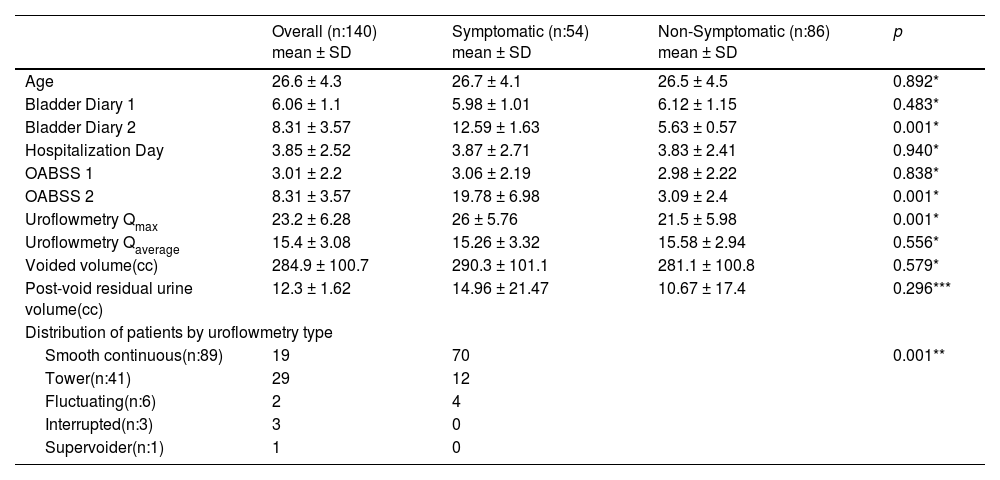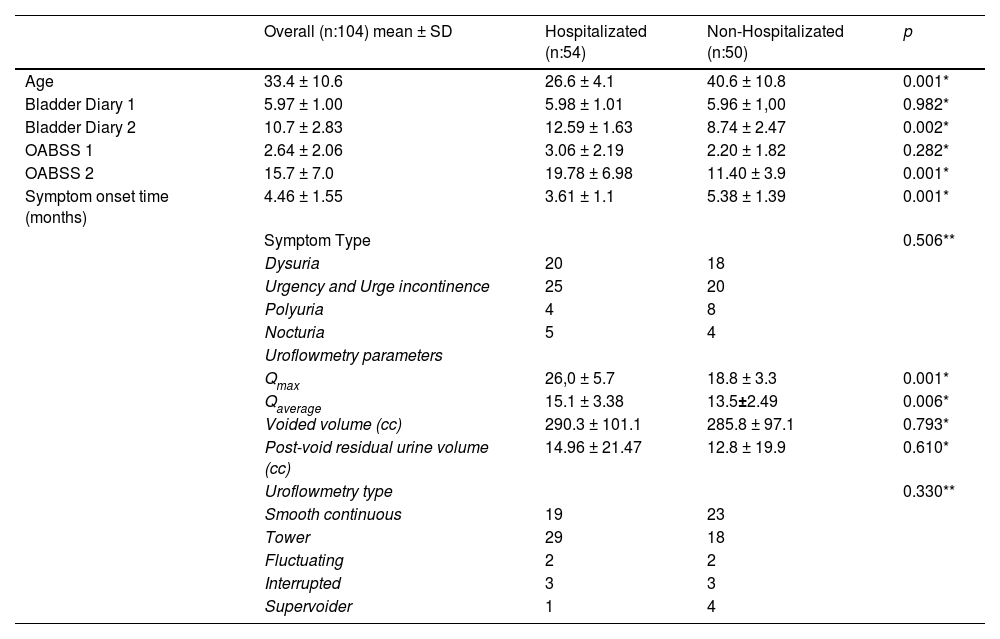To investigate female patients' post-COVID-19 voiding symptoms and to research how they relate to overactive bladder (OAB).
PatientsOne hundred and forty patients aged 20–50 years who were hospitalised and discharged due to COVID-19 at Kartal Dr. Lütfi Kırdar City Hospital between 2021 and 2022 and 50 patients with a history of COVID-19 among two hundred female patients who presented to the urology outpatient clinic with symptoms related to OAB were retrospectively analysed. Bladder diary, overactive bladder symptom score (OABSS), uroflowmetry values and time of onset of symptoms of symptomatic patients were recorded for all patients. Disease-free individuals for control purposes were not included in the study.
ResultsIt was observed that 38% of 140 hospitalized patients had a symptomatic change related to OAB, and there was a significant difference in voiding diary, OABSS, and uroflowmetry Qmax values between symptomatic and non-symptomatic patients after COVID-19. (p:0.001) There was a significant difference between the pre-COVID-19 (estimated) and post-COVID-19 (current) voiding diary and OABSS values of all symptomatic patients (with and without a history of hospitalization). (p:0.001) When these two groups were compared with each other, there was a significant difference between the post-COVID-19 voiding diary, OABSS values, and the meantime to the onset of symptoms in inpatients and outpatients (p:0.001)
ConclusionCOVID-19 may be associated with urgency/urge incontinence and overactive bladder in female patients.
Investigar los síntomas miccionales posteriores a COVID-19 de las pacientes femeninas y su asociación con la vejiga hiperactiva (VH).
PacientesSe analizaron retrospectivamente 140 pacientes de entre 20 y 50 años que fueron hospitalizadas COVID-19 y dadas de alta por en el Hospital Kartal Dr. Lutfi Kirdar entre 2021–2022, y 50 pacientes con antecedentes de COVID-19 entre doscientas pacientes femeninas que se presentaron en la consulta externa de urología con síntomas relacionados con la VH. Para todas las pacientes se registró el diario vesical, la escala de puntuación de síntomas de vejiga hiperactiva (OABSS por sus siglas en inglés), los valores de uroflujometría y el tiempo hasta la aparición de los síntomas de las pacientes sintomáticas. No se incluyeron en el estudio individuos libres de la enfermedad a efectos de control.
ResultadosSe observó que el 38% de las 140 pacientes hospitalizadas presentaba nuevos síntomas relacionados con la VH, y hubo una diferencia significativa en los valores del diario miccional, la OABSS y los valores de flujo máximo (Qmax) de la uroflujometría entre las pacientes sintomáticas y las no sintomáticas después del COVID-19. (p: 0.001) Hubo una diferencia significativa entre los valores del diario vesical y OABSS anteriores al COVID-19 (estimados) y posteriores al COVID-19 (actual) de todas las pacientes sintomáticas (con y sin hospitalización previa) (p: 0.001). Al comparar entre grupos, hubo una diferencia significativa entre el diario vesical post-COVID-19, los valores de la OABSS y el tiempo transcurrido hasta la aparición de los síntomas en las pacientes hospitalizadas y ambulatorias (p: 0.001).
ConclusionesEl COVID-19 puede estar asociado con urgencia/incontinencia urinaria de urgencia y vejiga hiperactiva en pacientes femeninas.










